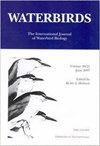加拿大不列颠哥伦比亚省哥伦比亚湿地湿地鸟类的丰度估算
IF 0.6
4区 生物学
Q3 ORNITHOLOGY
引用次数: 2
摘要
摘要哥伦比亚湿地是北美西部最大的连续湿地复合体之一。目前的人口估计对于指定优先保护区和可靠地评估受保护物种的人口状况是必要的。这项为期多年的研究(2016-2019)旨在使用标准化的呼叫广播协议和距离采样方法估计焦点和次要沼泽鸟类的丰度。焦点物种的丰度随年份而变化,平均种群估计表明最丰富的秘密沼泽鸟类是Sora (Porzana carolina;4605只),其次是美洲白骨顶(Fulica americana;2358只),弗吉尼亚铁路(Rallus limicola;2124鸟),以及嘴鸟(Podilymbus podiceps;1657只鸟)。次生物种以沼泽鹪鹩(Cistothorus palustris)最多;6328鸟),红翅黑鸟(Agelaius phoeniceus;5422只鸟),黄头黑鸟(黄头黑鸟;884只鸟)和威尔逊鹬(Gallinago delicata;445只鸟)。探测函数的生境协变量因物种而异,主要包括木本植被、高大植被和开阔水域;支持先前的研究,即“半沼泽”状态是许多沼泽鸟类的重要栖息地条件。哥伦比亚湿地提供了重要的湿地栖息地,这些估计强调了对不列颠哥伦比亚省鸟类保护的有效管理的必要性。本文章由计算机程序翻译,如有差异,请以英文原文为准。
Abundance Estimates for Marsh Bird Species in the Columbia Wetlands, British Columbia, Canada
Abstract. The Columbia Wetlands are one of the largest contiguous wetland complexes in western North America. Current population estimates are necessary for designation of priority conservation areas and for reliable assessment of population status for species of conservation concern. This multi-year study (2016–2019) was designed to estimate abundances of focal and secondary marsh birds using standardized call-broadcast protocols and distance sampling methods. Abundances of focal species varied by year, and mean population estimates indicated the most abundant secretive marsh birds were Sora (Porzana carolina; 4605 birds), followed by American Coot (Fulica americana; 2358 birds), Virginia Rail (Rallus limicola; 2124 birds), and Pied-billed Grebe (Podilymbus podiceps; 1657 birds). Most abundant secondary species were Marsh Wren (Cistothorus palustris; 6328 birds), Red-winged Blackbird (Agelaius phoeniceus; 5422 birds), Yellow-headed Blackbird (Xanthocephalus xanthocephalus; 884 birds), and Wilson's Snipe (Gallinago delicata; 445 birds). Habitat covariates for detection functions varied by species, tended to include woody vegetation, tall vegetation, and open water; supporting previous studies proposing that a ‘hemi-marsh’ state is an important habitat condition for many marsh bird species. The Columbia Wetlands provide important wetland habitat and these estimates underscore the need for effective management for the conservation of British Columbia’s avifauna.
求助全文
通过发布文献求助,成功后即可免费获取论文全文。
去求助
来源期刊

Waterbirds
生物-鸟类学
CiteScore
1.30
自引率
0.00%
发文量
0
审稿时长
6-12 weeks
期刊介绍:
Waterbirds is an international scientific journal of the Waterbird Society. The journal is published four times a year (March, June, September and December) and specializes in the biology, abundance, ecology, management and conservation of all waterbird species living in marine, estuarine and freshwater habitats. Waterbirds welcomes submission of scientific articles and notes containing the results of original studies worldwide, unsolicited critical commentary and reviews of appropriate topics.
 求助内容:
求助内容: 应助结果提醒方式:
应助结果提醒方式:


